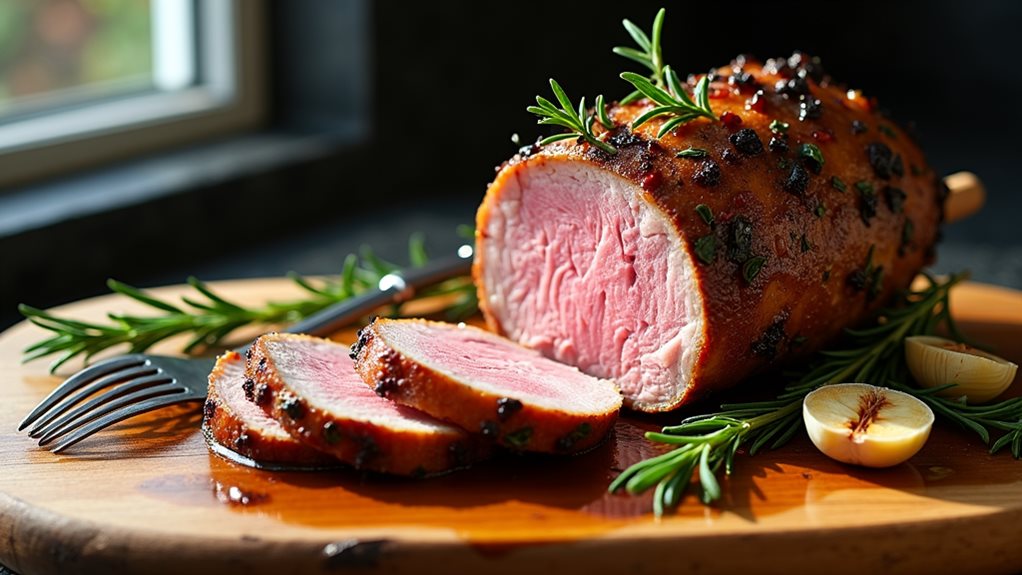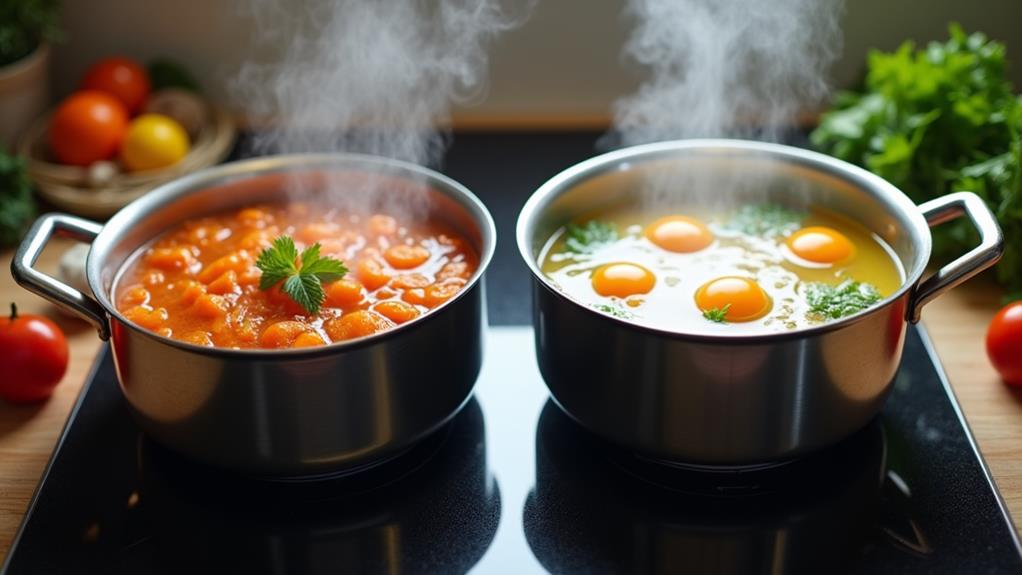Like a skilled artist crafting a masterpiece, you'll discover that preparing a slow-roasted leg of lamb requires patience, technique, and an appreciation for timing. When you're ready to elevate your cooking skills, this Mediterranean classic offers the perfect opportunity to showcase your culinary expertise. From selecting the right cut to mastering the balance of herbs and temperature, each step builds toward a dish that'll transform your dinner table into a memorable dining experience.
Key Takeaways
- Marinate leg of lamb overnight with garlic cloves inserted into small incisions and coat with olive oil, rosemary, salt, and pepper.
- Cook lamb in preheated 325°F oven on a roasting rack, basting periodically until desired internal temperature is reached.
- For optimal tenderness, cook to 125°F for rare, 135°F for medium-rare, or 145°F for medium, using a meat thermometer.
- Allow meat to rest for 15-20 minutes after cooking before slicing against the grain to maintain juiciness.
- Pair with roasted vegetables or potatoes, and experiment with different herbs while maintaining the classic garlic-rosemary base.
History
While lamb has been a dietary staple across many cultures for thousands of years, the specific technique of slow-roasting leg of lamb gained prominence in medieval European cuisine, particularly in regions where sheep farming flourished.
You'll find that this cooking method evolved from traditional spit-roasting, as indoor ovens became more common in European households during the 16th and 17th centuries.
The practice of studding lamb with garlic and herbs emerged in Mediterranean cooking traditions, where rosemary grew abundantly and garlic was prized for both flavor and medicinal properties.
By the 19th century, you'd see this preparation method documented in numerous cookbooks across Europe, cementing its status as a classic dish.
Today's slow-roasted lamb recipes haven't strayed far from these historical roots, preserving the time-tested techniques that create such memorable results.
Recipe
Slow-roasted leg of lamb is a timeless dish that transforms a premium cut of meat into a tender, flavorful masterpiece. The key to success lies in the slow cooking process, which allows the meat's natural flavors to develop while ensuring the final result is juicy and perfectly cooked.
This recipe focuses on a traditional preparation method that enhances the lamb's natural taste with simple, complementary ingredients. The combination of garlic, rosemary, and sea salt creates a classic flavor profile that has stood the test of time, while the low-and-slow cooking technique guarantees consistent results.
- 4-5 lb (1.8-2.3 kg) leg of lamb, bone-in
- 8 cloves garlic, peeled
- 1/4 cup (60 ml) olive oil
- 2 tablespoons fresh rosemary, chopped
- 2 tablespoons sea salt
- 1/2 teaspoon (2.5 ml) black pepper
Preheat the oven to 325°F (165°C). Remove the lamb from refrigeration 1-2 hours before cooking. Make small incisions throughout the meat and insert garlic cloves.
Combine olive oil, rosemary, salt, and pepper, then rub this mixture thoroughly over the entire surface of the lamb. Place the meat in a roasting pan and cook for approximately 20 minutes per pound, or until an internal thermometer reads 135°F (57°C) for medium-rare.
Remove from the oven and let rest for 15-20 minutes under loose foil before carving. For optimal results, position the lamb fat-side up in the roasting pan to allow the fat to baste the meat as it cooks.
A meat thermometer is essential for achieving your desired level of doneness: 125°F (52°C) for rare, 135°F (57°C) for medium-rare, or 145°F (63°C) for medium. Remember that the internal temperature will rise an additional 5-10 degrees during the resting period, so plan accordingly.
Cooking Steps
You'll want to start your slow-roasted leg of lamb preparation the night before by marinating the meat in olive oil, herbs, and garlic for maximum tenderness and flavor infusion.
On cooking day, begin by preheating your oven and preparing a roasting pan while making small incisions in the lamb to insert garlic cloves before coating the entire surface with your oil and herb mixture.
After roasting to your desired doneness, let the meat rest for 15-20 minutes, allowing the juices to redistribute throughout the lamb before you begin carving.
Step 1. Marinate Overnight for Tenderness
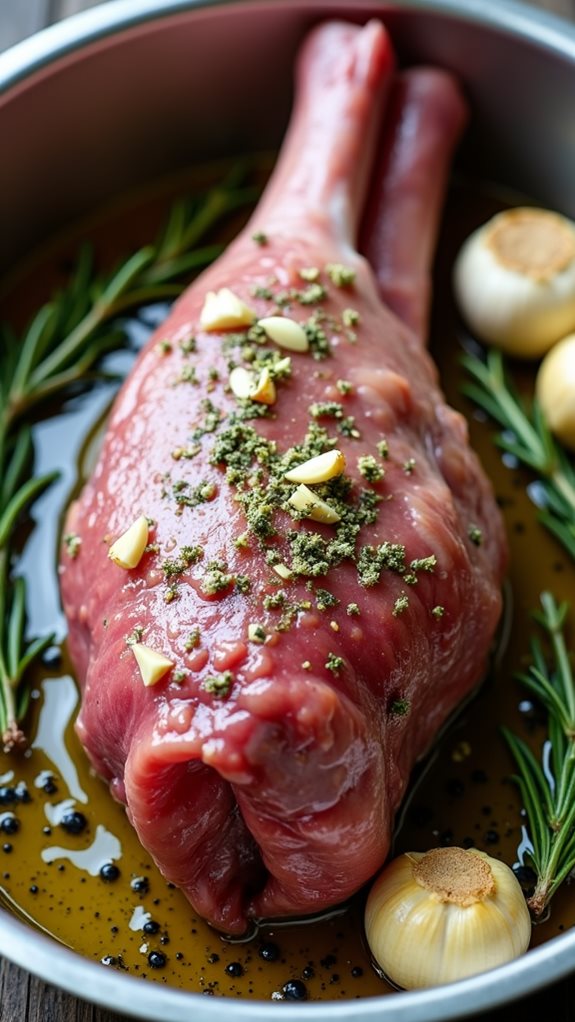
To achieve maximum tenderness and flavor infusion, start the preparation process the night before by creating a robust marinade for your leg of lamb.
Combine your olive oil with four crushed garlic cloves, chopped rosemary, and half the salt in a bowl, then whisk thoroughly until well-blended.
You'll want to pat the lamb dry with paper towels before massaging the marinade into every surface, paying special attention to any natural seams in the meat.
Place your seasoned lamb in a large, sealed plastic bag or covered container, ensuring the marinade coats all sides evenly.
Let it rest in your refrigerator overnight, turning once if possible to redistribute the marinade.
When you're ready to cook, remove the lamb from the refrigerator and let it come to room temperature for even roasting.
Step 2. Preheat and Prepare Pan
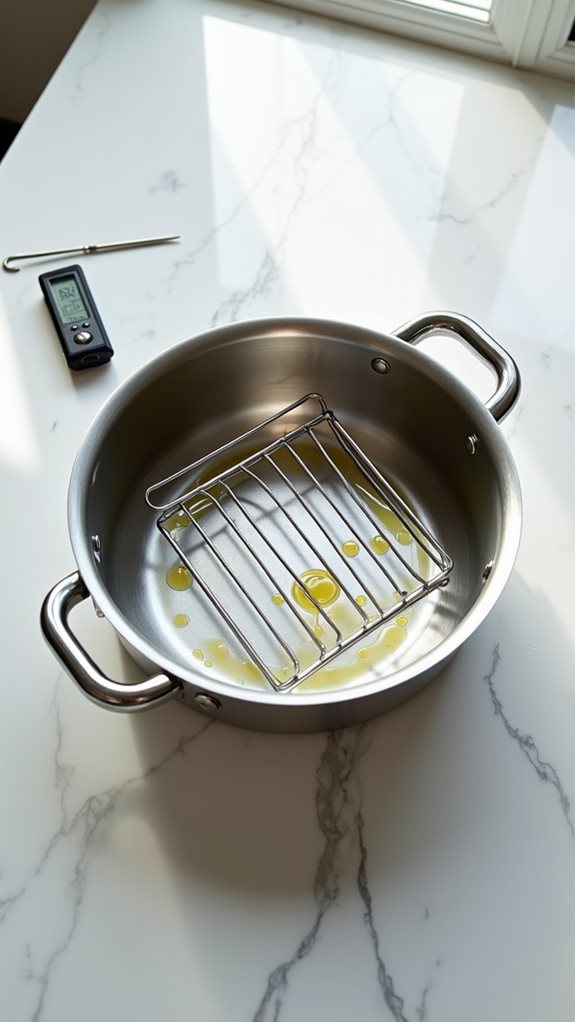
Before beginning the actual roasting process, position your oven rack in the lower third of the oven and preheat to 325°F (165°C), which allows the lamb to cook evenly while developing a perfect golden crust.
While you're waiting for the oven to reach temperature, select a sturdy roasting pan that's large enough to hold your leg of lamb with at least an inch of space around all sides.
Place a rack in the bottom of your roasting pan, as this will elevate the meat and allow hot air to circulate underneath.
If you don't have a proper roasting rack, you can create a makeshift one by arranging thick-cut onions or carrots on the pan's bottom.
Don't forget to lightly oil the rack to prevent sticking.
Step 3. Insert Garlic Into Cuts

With your preheated oven ready, the next step centers on infusing the lamb with deep garlic flavor.
Using a sharp knife, make 8-10 small incisions, about an inch deep, evenly spaced across the surface of the leg of lamb. Concentrate on the meatier sections, ensuring you don't cut too close to the bone.
Take your peeled garlic cloves and insert them firmly into these incisions, pushing them deep into the meat until they're completely embedded.
You'll want to work systematically, moving from one end of the roast to the other, making sure the garlic is distributed evenly throughout the meat.
This technique allows the garlic to slowly release its flavors into the lamb as it cooks, creating pockets of intense, savory taste in every slice.
Step 4. Coat With Oil and Herbs
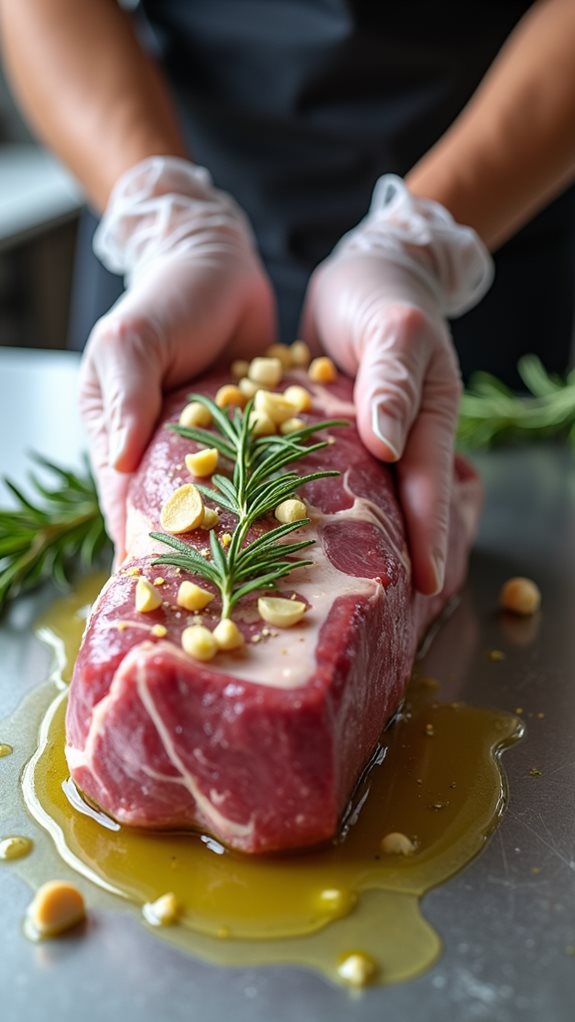
Drizzle olive oil generously over the entire surface of your garlic-studded lamb, ensuring complete coverage using your hands to massage it into every contour of the meat.
You'll want to create a uniform coating that will help the herbs adhere and promote even browning during the roasting process.
In a small bowl, combine the fresh rosemary and sea salt, mixing them thoroughly to create your herb coating.
Sprinkle this aromatic mixture evenly over the oiled lamb, pressing gently to help it stick to the surface.
Don't forget to season the underside and ends of the roast, as these areas contribute significantly to the overall flavor.
You'll notice the oil helping the herbs and salt form a flavorful crust that will develop beautifully during cooking.
Step 5. Rest Meat After Cooking
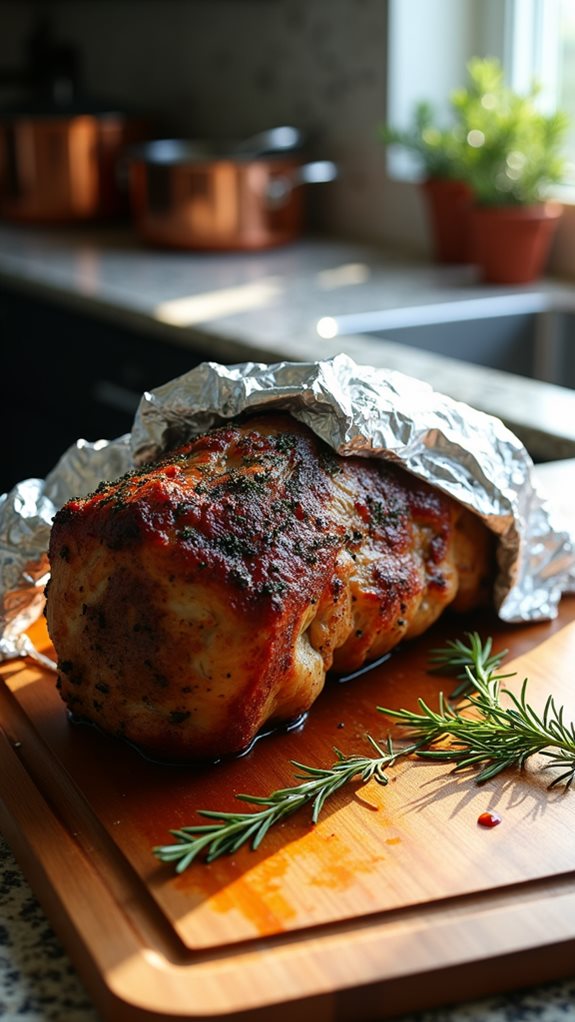
Once you've reached your desired internal temperature, carefully remove the leg of lamb from the oven and transfer it to a warm serving platter or cutting board.
Cover the meat loosely with aluminum foil, creating a tent that allows heat to circulate while keeping the lamb warm. Let it rest for 15-20 minutes, which allows the juices to redistribute throughout the meat.
During this resting period, the lamb's internal temperature will continue to rise by 5-10 degrees Fahrenheit through carryover cooking, so don't worry if you've removed it slightly before reaching your target temperature.
You'll know the meat has rested properly when the juices stay in the meat rather than running out when you slice it, resulting in moister, more flavorful servings.
Final Thoughts
Slow-roasting a leg of lamb may seem daunting at first, but you'll find that this method consistently delivers exceptional results that will impress your guests and satisfy your culinary ambitions.
The key to success lies in following the basic principles: proper temperature control, generous seasoning, and adequate resting time.
Don't be afraid to experiment with different herb combinations once you've mastered the basic technique, though the classic rosemary-garlic pairing remains a timeless choice.
Remember that patience is essential when slow-roasting lamb; rushing the process will only compromise the final result.
With practice, you'll develop an intuitive understanding of timing and temperature, making this impressive dish a reliable addition to your cooking repertoire.

